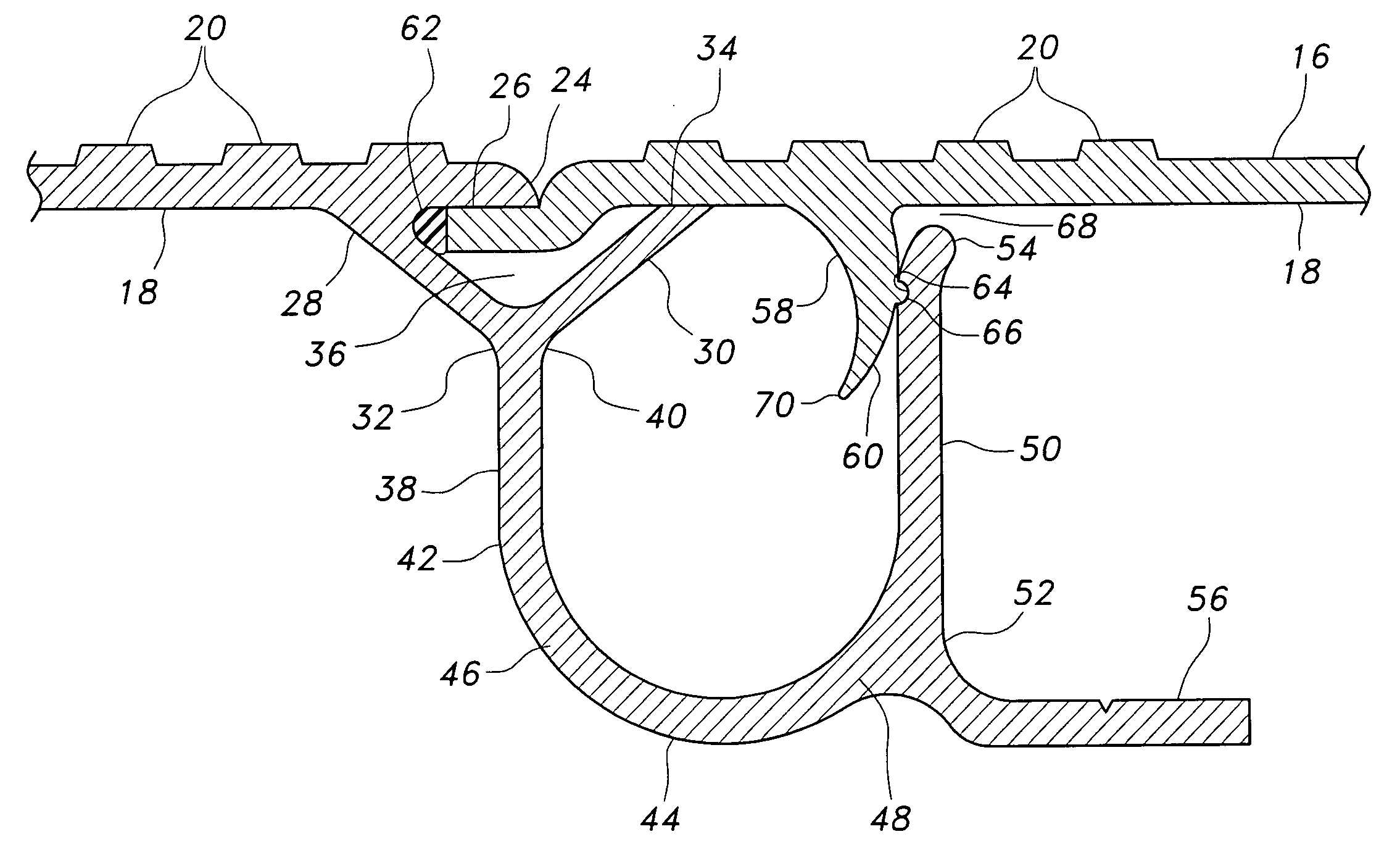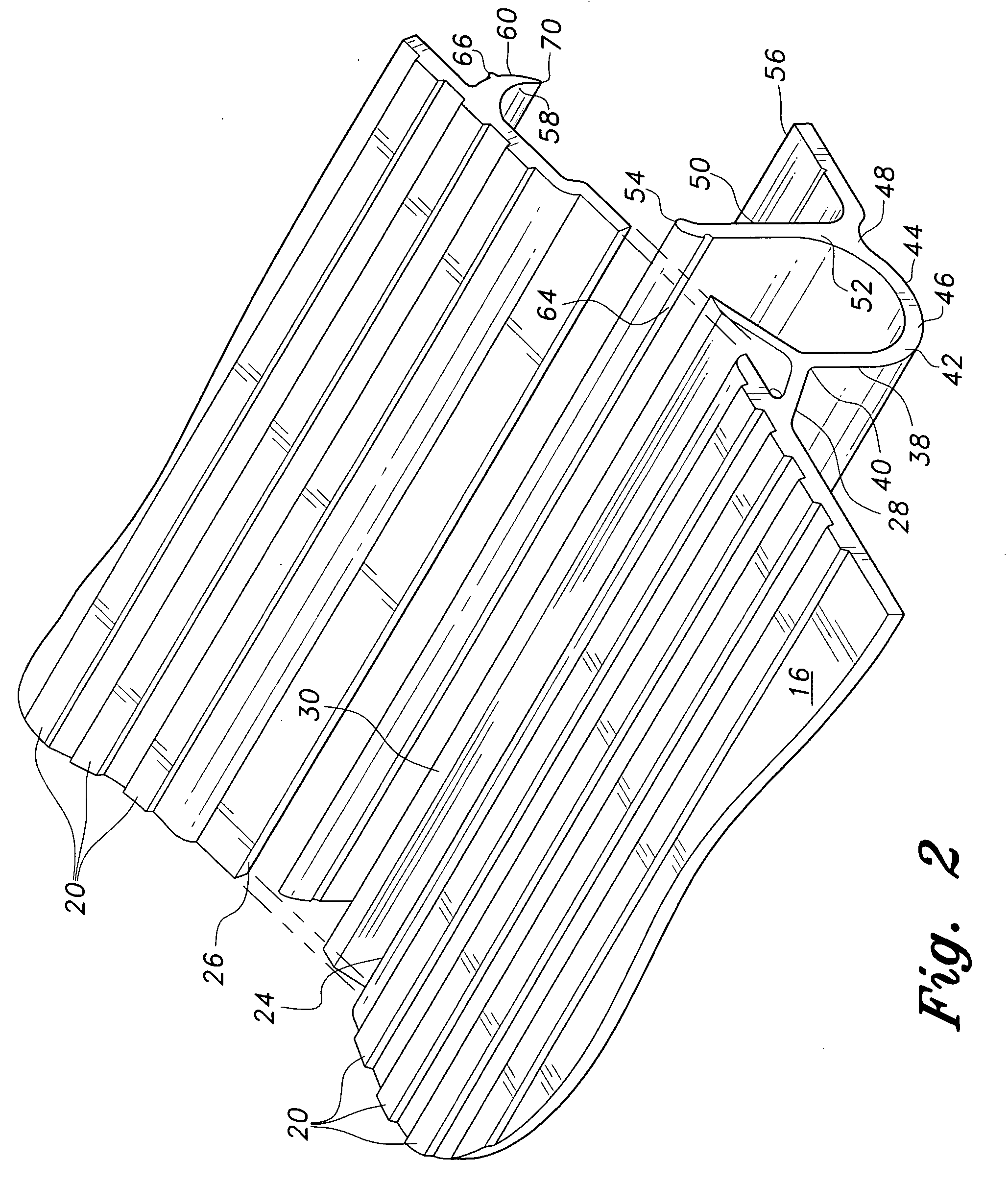Moreover, wood is not particularly durable when used as a
deck surface or in other areas where considerable
wear and tear may occur, and at the very least must be treated in some manner (pressure treatment, paint, etc.) in order to
resist deterioration due to
moisture.
However, the fact that such panels are somewhat limited in their maximum width due to constraints involved in the
extrusion process and shipping results in the need to assemble a series of such extrusions together in order to provide the desired width for most deck installations.
While such an
assembly can be constructed to form a structurally sound installation, the slight gaps between the assembled panels generally allow rain or other
moisture to pass therethrough.
Thus, such extruded panels are generally unsuitable for use as a deck or roof surface overlying a room or other area which must be kept dry, unless additional
waterproofing in the form of an underlying
substructure covered with tarpaper, plastic sheeting, or some other waterproof material, is provided.
While some attempts have been made to form extrusions that provide a truly waterproof joint, the fact remains that none of the decking extrusions of which the present inventors are aware provide a truly waterproof surface when assembled.
The Simpson roof panels are so thin and light, that they cannot support the weight of a person thereon by themselves.
Simpson does not provide any form of drain channels beneath his roof panels.
However, the
interlocking portions are upstanding when the panels are used for roofing.
The raised interlocked edges render the Oehlert panels unsuitable for use as a deck for walking upon.
In any event, the
thin sheet metal from which the Oehlert panels are formed do not provide sufficient structural strength to serve as a deck.
While Oehlert does provide channels within the interlocked edges of his panels, they are not waterproof, as fasteners are driven through the floors of the channels to anchor the
assembly to the underlying structure.
Moreover, the
thin sheet metal of the Tor panels do not provide sufficient structural strength for walking upon and / or supporting relatively heavy articles, e.g., outdoor furniture, etc., as would normally be found on a deck.
The panels of the Hallsten structure
interlock, but no waterproof joints are provided due to their environment as a dock overlying a body of water.
Accordingly, Hallsten does not provide any form of drainage channels or gutters beneath the joints of his panels, whereas the present extruded panels include such drainage channels underlying each joint between panels.
Thus, the Davis panels are not at all waterproof and cannot be installed over a room or other space which must remain dry, unless considerable
waterproofing (e.g., the installation of tarpaper, etc.) is accomplished beneath the panels.
This construction cannot provide a truly waterproof deck.
While the Conn patent shows various shapes for the extreme edge configurations of the second panel, no resilient sealing means are provided by Conn to positively seal the joint against moisture seepage therethrough.
In fact, due to the very
high pressure developed by the edge of the second panel bearing against the underside of the first panel, any resilient sealing means applied between these two contact lines would be quickly worn away.
The present inventors' experience with the Conn panels shows that this lateral motion, along with the tight interference between adjacent panels, results in squeaks, groans, and other unpleasant noises being produced by the Conn panel joints as the “contact” of the second panel rubs and bears against the underside of the first panel in the trough.
Such panels cannot support any significant weight and must be supported by some underlying structure, as is clear from the drawings of the Seem roof panel
system.
Elsasser et al. note that their extrusions may be used for roof decking or the like, but they fail to provide any means of interconnecting adjacent
extrusion components to provide any sort of watertight (or other) joint between them.
 Login to View More
Login to View More 


